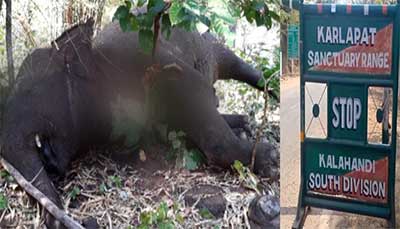Death of six elephants in the Karlapat Wildlife Sanctuary in Kalahandi
7 elephant recently died in Odisha due to bacteria from cattle. A Central team set up by the Ministry of Environment, Forests and Climate Change to look in to the death of six elephants. In its preliminary report the team pointed to a disease, Haemorrhagic Septicemia, caused by a bacteria called pasteurella multocida as the reason behind death. Two cattle were also found dead in the sanctuary. After conducting post mortem and RNA extraction tests, the samples have now been sent to the Indian Veterinary Research Institute in Bareilly, UP, for a final confirmation.
About the pasteurella multocida bacteria, the main culprit :
Pasteurella multocida are bacteria found commonly in the respiratory tract of herbivores, especially in cattle. The bacteria rapidly multiply and move from the respiratory tract to the bloodstream only when the animal’s body faces stress, has low immunity or is unhealthy.This causes diarrhoea and often haemorrhagic septicemia, which can be fatal.
About Karlapat sanctuary in Odisha :
Karlapat sanctuary is located in Kalahandi South Division which is 12km from Bhawanipatna in Kalahandi district covering a dense patch of lush green dry deciduous forest. A beautiful waterfall,'Phurlijharan' has been developed as a picnic spot for the local visitors and draws large number of visitors from far off places in and around Kalahandi District. Karlapat Wildlife Sanctuary is home to a plethora wildlife animals and birds.The sanctuary is rich in wildlife such as leopard, gaur, sambar, nilgai, barking deer, mouse deer,soft claws ottawa, a wide variety of birds and reptiles.
A temple dedicated to Goddess Manikeswari is also located in Bhawanipatna city in the region.
About project elephant :
Elephant is an animal included in Schedule-I of the Wildlife (Protection) Act, 1972. A complete ban on ivory trade was imposed in 1991. Project Elephant was launched in February 1992 by Govt. of India to consolidate the programmes for conservation of elephant and its habitat. The Project seeks to address (a) the threats to the survival of elephant in our country on account of loss of its habitat, migration path and poaching for tusks; and (b) issues arising out of elephant depredation in villages. Project Elephant also seeks (i) to maintain an appropriate size of the population in any habitat to safeguard it against extinction; and (ii) to maintain genetic continuity of isolated populations, which are otherwise susceptible to inbreeding.
Project Objectives :
- To conserve and protect elephant populations and to ensure that any population remains healthy and viable within its ecosystem.
- To conserve and protect the habitat of the elephant, and to reverse the deterioration of these habitats.
- To conserve, protect, and open up traditional migration corridors linking the different habitats.
- To create conditions, through eco-development activities, welfare measures and mitigation of elephant depredation for nurturing the traditional compassion and tolerance of the people living in and around elephant habitats.
- To take concrete measures to protect the elephant from poaching and other threats.
- To create viable mechanisms to ensure inter-state and inter regional coordination in protecting and conserving the elephant and its ranges.
- To create infrastructure and facilities, including training of manpower, for conservation support activities, veterinary care, humane methods of tranquilising and translocation, etc.
- To encourage, and create facilities for research related to the ecological significance of elephant and veterinary care of the animal.
- To educate people about the ecological significance of conserving the elephants and to revive the historical reverence and compassion for elephants.
- To devise strategies and programmes of providing alternative source of livelihood to craftsmen and communities adversely affected due to ban on the trade of ivory products.







